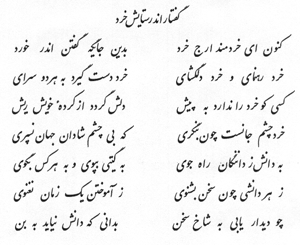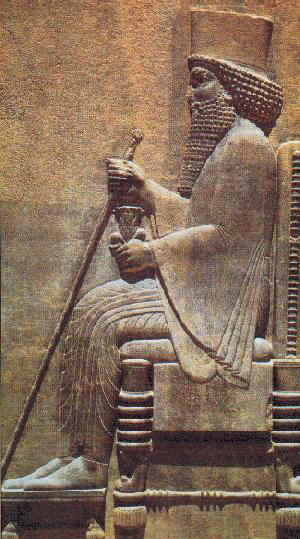In
the last analysis, it was the Shahnameh, Ferdosi’s poetical work of
universal literary rank, that became the milestone for the self affirmation
of Iranian identity. For the Iranian people indeed live in and
by means of their poets; and the importance of the poems of Ferdosi
for the preservation of the Iranian character can in no way be overestimated.
Iran in Fruh-Islamischer Zeit, Bertold Spuler,

The
Shahnameh is an impressive monument of poetry and historiography,
being mainly the poetical recast of what Ferdosi and his predecessors
regarded as the account of Iran's history. An account which
already existed in a less appealing form in prose works, especially
in the Shahnameh of Abu Mansur Abd-al-Razzaq. A small portion
of Ferdosi’s work, in passages scattered throughout the Shahnameh,
is entirely of his own conception. In addition to the profound
descriptions of various scenes and phenomena, expresses his reflection
on life, his religious and ethical beliefs and his admiration of virtue,
his praise for his patrons, and his references to the sources he used.
The rest of the work is divided into three successive parts: the mythical,
heroic, and historical ages. Ferdosi, in these passages, expresses
his reflection on life, his religious and ethical beliefs and his
admiration of virtue, his praise for his patrons, and his references
to the sources he used. The rest of the work is divided into
three successive parts: the mythical, heroic, and historical ages.
The
mythical age: After an opening in praise of God and Wisdom,
the Shahnameh gives an account of the creation of the world and of
man as believed by Sassanians. This introduction is followed
by the story of the first man, Gayumarth, who also became the first
king after a period of mountain dwelling. He accidentally discovered
fire and established the Sadeh Feast in its honor. Stories of
Tahmureth, Jamshid, Zahhak, Kaveh, Freidun and his three sons: Salm,
Tur, and Iraj, and Manuchehr are explained in this section.
This portion of the Shahnameh is relatively short, amounting to some
2100 verses or four percent of the entire book, and it narrates the
events with the simplicity, predictability, and swiftness of a historical
work. Naturally, the strength and charm of Ferdosi’s poetry
have done much to make the story of this period attractive and lively.
The
heroic age: Almost two-thirds of the Shahnameh is devoted to the age
of heroes, extending from Manuchehr’s reign until the conquest of
Alexander. The main feature of this period is the major role
played by the Sagzi (Saka) or Sistani heroes who appear as the backbone
of the Iranian empire. Garshasp is briefly mentioned
as is his son Nariman, whose own son Sam acted as the leading paladin
of Manuchehr while reigning in Sistan in his own right. His
successors were his son Zal and his son Rostam, the bravest of the
brave, and then Faramarz.
The
feudal society in which they lived is admirably depicted in the Shahnameh
with accuracy and lavishness. Indeed, Ferdosi’s descriptions
are so vivid and impressive that the reader feels himself participating
in the events or closely viewing them. The tone is significantly
epic and moving, while the language is extremely rich and varied.
Among
the stories described in this section are the romance of Zal &
Rudabe, the Seven Stages (or Labors) of Rostam, Rostam and Sohrab,
Siavash and Sudabe, Rostam and Akvan Div, the romance of Bijan and
Manije, the wars with Afrasiab, Daqiqi’s account of the story of Goshtasp
and Arjasp, and Rostam and Esfandyar.
It
is noteworthy to mention that the legend of Rostam and Sohrab is attested
only in the Shahnameh and, as usual, begins with a lyrical and detailed
prelude. Here Ferdosi is in the zenith of his poetic power and
has become a true master of storytelling. The thousand or so
verses of this tragedy comprise one of most moving tales of world
literature.
The
historical age: A brief mention of the Ashkanian (Arsacids) follows
the history of Alexander and precedes that of Ardeshir. After
this, the Sassanian history is related with a good deal of accuracy.
The fall of the Sassanian and the Arab conquest are narrated romantically,
and in a most moving poetic language. Here, the reader could
easily see Ferdosi himself lamenting over this catastrophe, and over
what he calls the arrival of “the army of darkness”.
According
to Ferdosi, the final edition of the Shahnameh contained some sixty
thousand distiches. But this is a round figure; most of the
relatively reliable manuscripts have preserved a little over fifty
thousand distiches. Nezami-Aruzi reports that the final edition
of the Shahnameh sent to the court of Soltan Mahmud was prepared in
seven volumes.
Ferdosi’s
style is that of a superb poet. His epic language is so rich,
moving and lavish that it truly enchants the reader. Personal
touches in the Shahnameh prevent it from falling into a dry reproduction
of historical narratives. No history has been so eagerly read,
so profoundly believed, and so ardently treasured in Iran, as has
the Shahnameh of Ferdosi. If a history were ever to influence
its readers, the Shahnameh has done and still does so in the finest
way. Where many Iranian military and religious leaders failed,
Ferdosi succeeded. With the Shahnameh, the revival and immortality
of a nation became possible.
Ferdosi
did not expect his reader to pass over historical events indifferently,
but asked him to think carefully, to see the grounds for the rise
and fall of individuals and nations; and to learn from the past in
order to improve the present, and to better shape the future.
The
Shahnameh stresses that since the world is transient, and since everyone
is merely a passerby, one is wise to avoid cruelty, lying, avarice,
and other evils; instead one should strive for justice, truth, order,
and other virtues which bring happiness, ease, and honor.
The
singular message that the Shahnameh of Ferdosi strives to convey is
the idea that the history of Iranshahr was a complete and immutable
whole: it started with Gayumarth, the first man, and ended with his
fiftieth scion and successor, Yazdegerd III, six thousand years of
history. The task of Ferdosi was to prevent this history from
losing its connection with future Iranian generations.
Source:
Ferdowsi, A Critical Biography, by A. Shapur Shahbazi, Published by
Mazda Publishers, 1991 The
Shahnameh, Abu'lQassem Ferdowsi, Edited by Djalal Khaleghi-Motlagh,
Vol. I, 1988.



